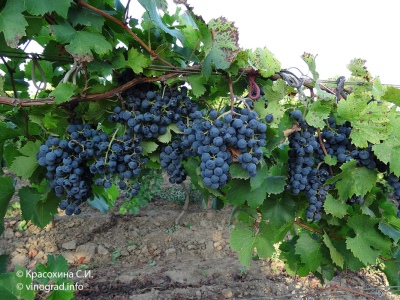
- Authors: Gerhard Halleveld, Federal Research Institute for Grape Breeding, Geilweilerhof, Germany
- Appointment: technical
- Berry color: black
- Taste: harmonious, sometimes with grassy tones
- Ripening period: mid-late
- Ripening period, days: 135-140
- Frost resistance, ° C: -27
- Name synonyms: Gailweilerhof 67-198-3, Regent
- Bunch weight, g: 150-180
- Flower type: bisexual
The country of origin of the Regent variety is Germany. Breeder Gerhard Alleveld developed a complex hybrid at the Federal Research Institute for Grape Breeding Gailweilerhof.
Breeding history
The regent was obtained by crossing the white variety Diana, which is also bred from 2 varieties (Müller Thurgau x Silvaner), and Chamboursen, an old variety from France. Began to be used on sites since 1967. In 1996, the Regent was recognized as the best dark berry variety for winemaking (technical purpose). You can find the name of the variety Geylweilerhof 67-198-3, Regent.
Geography of distribution
The regent is grown in different countries of Europe, where it is cool. In Russia and Ukraine, it is distributed under the name Black Alan.
Description
The bushes are medium-sized with strong broad branches. The leaves are of medium size with a small dissection and have a five-lobed shape. The petiole notch is open, sometimes lyre-shaped. Young leaves are light green, sometimes with a pink border around the edges and strong pubescence.
Ripening period
Regent is considered a mid-late variety. The berries ripen in 135-140 days.
Bunches
Grape cluster of cylindrical conical shape of medium size, moderate density. Weighs no more than 180 g.
Berries
Round fruits are black with a bluish tinge. The weight of one medium-sized berry is 1.5 g. The pulp is light blue-violet in color.
Taste
The regent contains sugar 200-220 g / dm 3, the acidity is 8 g / dm 3. The harmonious taste of pronounced nutmeg is intertwined with herbal notes.
Yield
Fruiting shoots of the Regent ripen by 80%. This variety is considered to be high yielding.


Growing features
If the Regent is grown in the southern regions, then hilling will be required. This is necessary to keep moisture in the soil longer.
Landing
A calm, well-lit place is suitable for growing. Better if it is on the south side of the garden. When landing the Regent, you should:
- take into account the size of the pit - 80 cm;
- a peg should be driven into the center of the hole and drainage should be poured up to 10 cm, which should also be covered with earth with a layer of about 10 cm;
- then fill the hole with fertile soil mixed with mineral fertilizers;
- then place a seedling in the center, distribute the roots over a mound and tie it to a support;
- in the end, sprinkle with soil, water and mulch with peat;
- the distance between plants is 1.5 m.

Pollination
The Regent's flower is bisexual and does not need pollination. The process takes place without the additional participation of insects.
Pruning
In the fall, the Regent is pruned:
- remove side shoots;
- lignified branches are cut at right angles;
- as soon as the flower whiskers are formed, all weak and diseased stems are removed;
- a week before flowering, 2/3 of the tops are pinched;
- the number of eyes is normalized: 60–80 pieces are left on one bush;
- pruning of vines is limited to 3-4 eyes.

Watering
Drying out of the soil is detrimental to the plant. Watering is necessary in the spring before the beginning and end of flowering. In the summer they water it when the berries begin to ripen.


Top dressing
The regent prefers sandy, sandy loam, clayey, loamy soil. Especially in need of supplementation with magnesium. Before the winter period, you need to feed the Regent with organic matter: compost, manure, peat.
Frost resistance and the need for shelter
The grape variety is frost-resistant and can withstand temperatures down to -27 ° C. Many gardeners believe that seedlings up to 3 years old need insulation. For shelter, it is enough to use a layer of sawdust up to 5 cm. You can cover the vines with agrofibre, having previously removed them from the supports.

Diseases and pests
The variety is resistant to many pests and diseases, but there is a possibility of being affected by mildew, or, as it is also called, powdery mildew. Sustainability score 2 points. Susceptibility to powdery mildew and gray rot - 2.5 points. It is bad that it can manifest itself at any stage of the growing season. Resistance to root and leaf phylloxera is 3.5 points.

If a grape is exposed to any disease or insect, this always affects its appearance.
Storage
The harvest is harvested all at once. It is impossible to overexpose the bunches on the vine, as the required level of acidity decreases, which is of great importance in the production of wine, compotes, natural juices.
Review overview
Gardeners leave a lot of good reviews about this grape. Some call the Regent a reference variety. The minimum of disadvantages is irrelevant compared to the advantages of this variety. Regent has a rich aroma, rich taste, deep red-violet color. Sufficient sugar content allows you to enjoy the unique taste of fresh berries.











































































